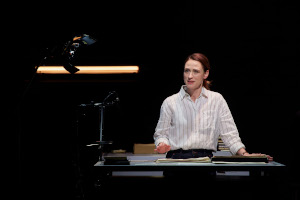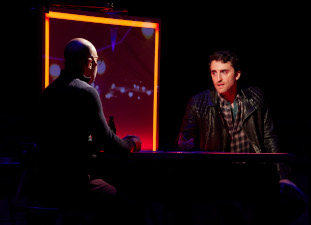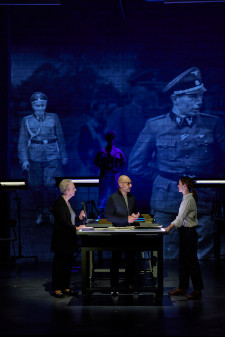
Dorothy
Chansky
| “Here There Are Blueberries”
Shakespeare Theatre
Company It’s hard to imagine a greater ideological or social polarity than the one between Nazi sympathizers and concentration camp prisoners, but a look at experiences on both sides of the divide and into the abyss separating them is exactly what The Tectonic Theater Project has staged in “Here There Are Blueberries.” The articulate, nuanced, and highly theatrical play started life at the La Jolla Playhouse in 2022 and will open in Manhattan next year as part of New York Theatre Workshop’s 2023-24 season. For three weeks it is in Washington. It is stunningly good. The two stars of the piece are a long-lost photo album and a behind-the-scenes (until she isn’t) museum curator with a Ph.D. in American history and a specialization in World War II and U.S. immigration policy. You may think this is a recipe for a dull slog through a course syllabus with pictures, but you would be wrong, except about the pictures. More like a (mass)murder mystery and a plunge into the everyday—including our own.
The story begins when said Ph.D., a young archivist at the United States Holocaust Museum, starts to examine a photo album given to the museum by an anonymous donor who retrieved it from a Frankfurt apartment shortly after the end of the war. The archivist, Rebecca Erbelding (played with a perfect balance of passion and restraint by Elizabeth Stahlman), imagines she will find yet another compilation of inmate images, but to her great surprise, the album features pictures of Nazi officers (all male) and a few secretaries (female), with nary a malnourished victim in sight. Via careful sleuthing, Erbelding and her colleagues ascertain that this rare trove of Auschwitz images was the personal collection of the camp commandant’s aide, one Karl Höcker, who appears in most of the shots and in whose handwriting they are all captioned.
To show them, or not to show them. That was the question. Erbelding argues for full disclosure; others in the museum hierarchy are not so sure. Won’t their usual audiences and supporters resist smiling images of Nazis looking healthy and confident on the grounds of what is arguably the most infamous concentration camp of the Holocaust? A commitment to the full picture of a history that, like all history, can never be completely known or understood, prevails. The photos are made available to the public, and, since it’s the twenty-first century, this means online. That’s when the plot thickens.
A man in Germany, Tilman Taube (played with conviction and humility by Maboud Ebrahamizadeh), recognizes a face in one of the pictures. It is that of his grandfather, who was a highly placed medical doctor and sometime visitor to Auschwitz. The first to come forward, Taube offers to help persuade other descendants of men in the photos to step up with what they know and remember. Like many participants in and survivors of World War II, the grandparents didn’t much want to talk about their experiences. The photos, however, suggest the skeleton of a story. Postwar news items and interviews put meat on the bones. Höcker, the album creator, who was apprehended and tried after the war, remained unrepentant until his demise in old age. In the photo collection, he is a twenty-something rubbing shoulders with top brass and seemingly having the time of his life. As an elderly man, seen in news footage, he hides his face from cameras behind a newspaper. In “Blueberries” he is played by a no-nonsense Scott Barrow in the post-war phase. Like many of the lower ranking Nazi military and some of the women who were switchboard operators and secretaries, Höcker came from a very modest background and was in a dead-end job (in his case, bank clerk, but others were bakers and accountants, if they had jobs at all) when party membership beckoned with the promise of pay, patriotic service, and status. As the play notes, the album—which features photos taken right up until the camp’s prisoners were liberated—brings out the disconnect between reality in the world (war, violence, poverty, arrests, hideous programs of social engineering, propaganda, deprivation, racism, etc.) and life for the Nazis in the camp (smiles, trips to a riverside vacation lodge, plenty of food—including those blueberries), clean clothing, hot and cold running slave labor). The world of the photos was for the privileged Nazi officers an ideal world. The weather is always good and there is nary a Jew in sight. The Tectonic Theater Project’s artistic director, Moisés Kaufman, read an article about the album in The New York Times, and was intrigued. He contacted Erbelding, and the germ of a play emerged. Tectonic’s previous “Laramie Project” and “Three Trials of Oscar Wilde” showed audiences how rigorous research, interviews, responsible devising, and a lens optic can yield informative (because informed) and emotionally powerful theatre with morality but without polemic. In a program note by Amy Marie Seidel, the Associate Director, Dramaturg, and Deviser for “Here There Are Blueberries,” when the core company members of Tectonic visited Auschwitz and its surrounding area “we chiseled away at the distance between ourselves and the photographs.” So, are “we” like “them?” No and yes, sort of maybe, sometimes. In one of the play’s most powerful performances, Charlie Thurston plays Rainer Höss, grandson of Auschwitz’s long-time commandant, Rudolph Höss. The elder Höss was tried and hanged after the war, most of which he spent with his wife and five children in a very comfortable villa inside the camp compound. Rainer, who confesses to a young adulthood characterized by worshipping violence and power (which included beating people up for fun), first imagines that he has inherited something from this forebear. When he learns, however, that he is to be a father, he decides that his predilections have to change. Thurston depicts a man in the thrall of brutality with scary gusto; he then transitions to new awareness and answers his interviewer’s question about changing his name with the observation that by keeping it, he aims to show that Höss need not be a moniker of perpetual shame. He will model something different. He is part of the project of speaking out, to avoid what another character labels the silence that transfers trauma to the next generation. At the opposite end of the characterological spectrum, the versatile and persuasive Erika Rose plays the wartime Melita Maschmann, whose appearance in the play reminds us of what Hannah Arendt so memorably called the banality of evil. Maschmann, born just months before the end of the first World War, grew up in an impoverished, defeated country. As a child, feeling loyal and patriotic, she admired and envied the smiling, uniformed, athletic, and healthy members of the League of German Girls (Bund Deutscher Mädel, or BDM), a Nazi youth organization started in the early 1920s. A mass event featuring the League in 1932 appealed to the fourteen-year-old Maschmann, who joined the organization the next year and later became a higher-up in the BDM’s press and propaganda office. The BDM was, according to the play’s Maschmann, “a way to belong.” The real Maschmann was arrested in 1945, “deNazified,” and later released. The memoir she subsequently wrote is one of remorse, and a 2013 article about her in The New Yorker details her attempts (mostly rebuffed) to make amends to the Jewish schoolmate she had betrayed and harmed. Another story of putatively ordinary longing for “betterment,” commitment, service to country, and maybe adventure. As one line in “Blueberries” notes, the Nazi enterprise would have been impossible without the cooperation of the “professional class,” including clergy, doctors, journalists, and lawyers. As well as their wannabes, admirers, hangers-on, and aides.
I promised both sides of the coin, and the play hardly seeks to ignore or repress victims of the atrocities committed by the deluded, sheltered, privileged fascists whose everydays were documented photographically by a true-believer sycophant. While many claimed to have known nothing of the big picture (they were just “doing their job,” each one a cog in a machine they neither designed nor claimed to recognize), one character scorns the way ordinary Germans ran after Hitler, but also the way ordinary viewers of the album photos disconnect from what they are seeing. The redoubtable Kathleen Chalfant is an interview subject (she also plays the chief acquisitions curator of the Holocaust Museum, which means being Erbelding’s boss) who tartly notes that Hitler Superstar “wasn’t even German,” adding that people always follow megalomaniacal rabble rousers like that. “You know who was the first? Jesus.” People who viewed the smiling family men and wholesome young women in the photos refused to connect them to the policies these Nazis devised and implemented, noting how “normal” and “just like us” they look in the pictures. Indeed. The final scene of the piece features Stahlman in the role of Lili Jacob, a survivor of Auschwitz who, on the day of her liberation, found in a small room in a camp building a photo album in the bottom of a nightstand drawer. In a “what are the odds?” moment, we learn that one of the photos in that album is of her on the day she arrived at Auschwitz—a day close to the one when Höcker arrived at the camp. Two roads diverged. The woman finally decided that it was more important for the world to have access to the album than it was for her to hold onto it. The effect of the play is unthinkable without the work of projection designer David Bengali, who shows us the photos individually and in relation to each other and also facilitates (with lighting designer David Lander) spotlighting individual figures and faces. Scenic designer Derek McLane makes possible a shifting sense of place, as museum worktables roll away and make room for benches, interview rooms, and other more intimate places.
As much as people, philosophy, and plot kept me riveted to this piece, the first player to be introduced is the portable camera (a projected image of a vintage Leica). Without said item we would obviously have infinitely less information about the people in the pictures (there would be no pictures) but also about the phenomenon of creating the artifacts themselves. Amateur photographers were historians, even if inadvertent ones, and the moments they chose to memorialize, such as a one of a row of female telephone and telegraph operators eating blueberries at a vacation lodge on a holiday from their work in an extermination camp full of starving prisoners, speak volumes. Practicing historians know that history is both the stuff that happened and also the telling that recounts that stuff. Which is why a history of whatever is always just that—A history. “Here There Are Blueberries” is performed historiography. And it merits an A+. |
| recordings | coupons | publications | classified |





